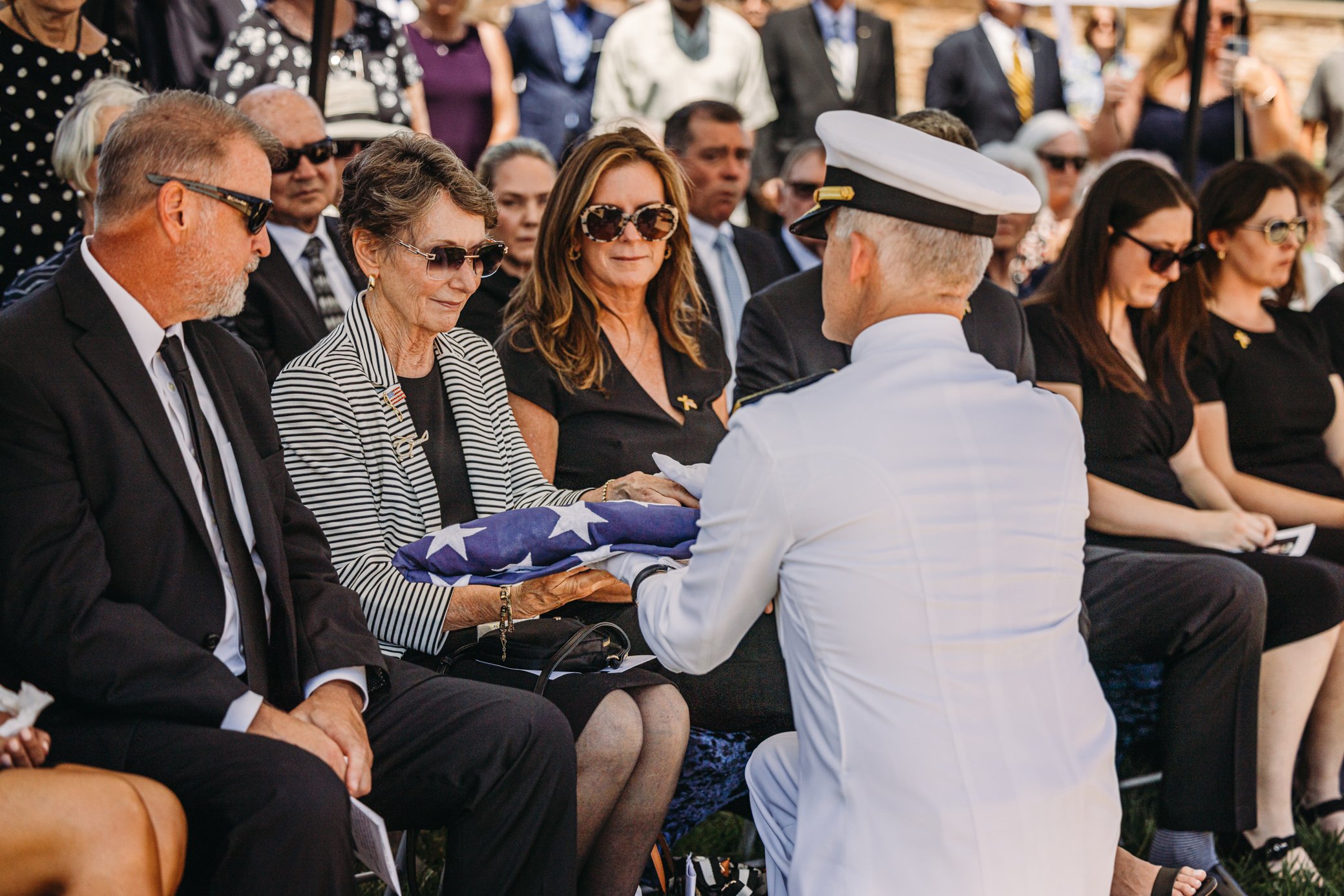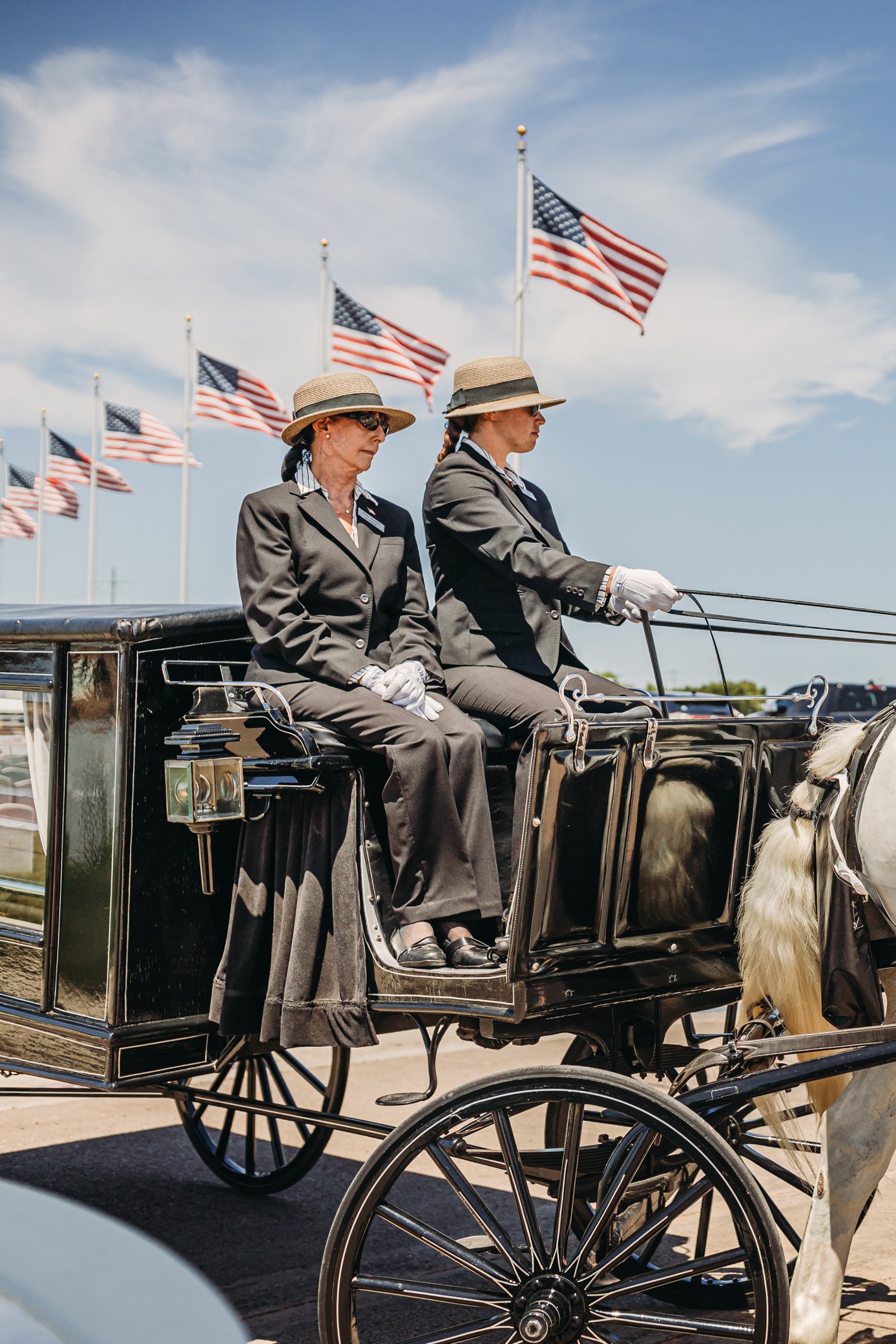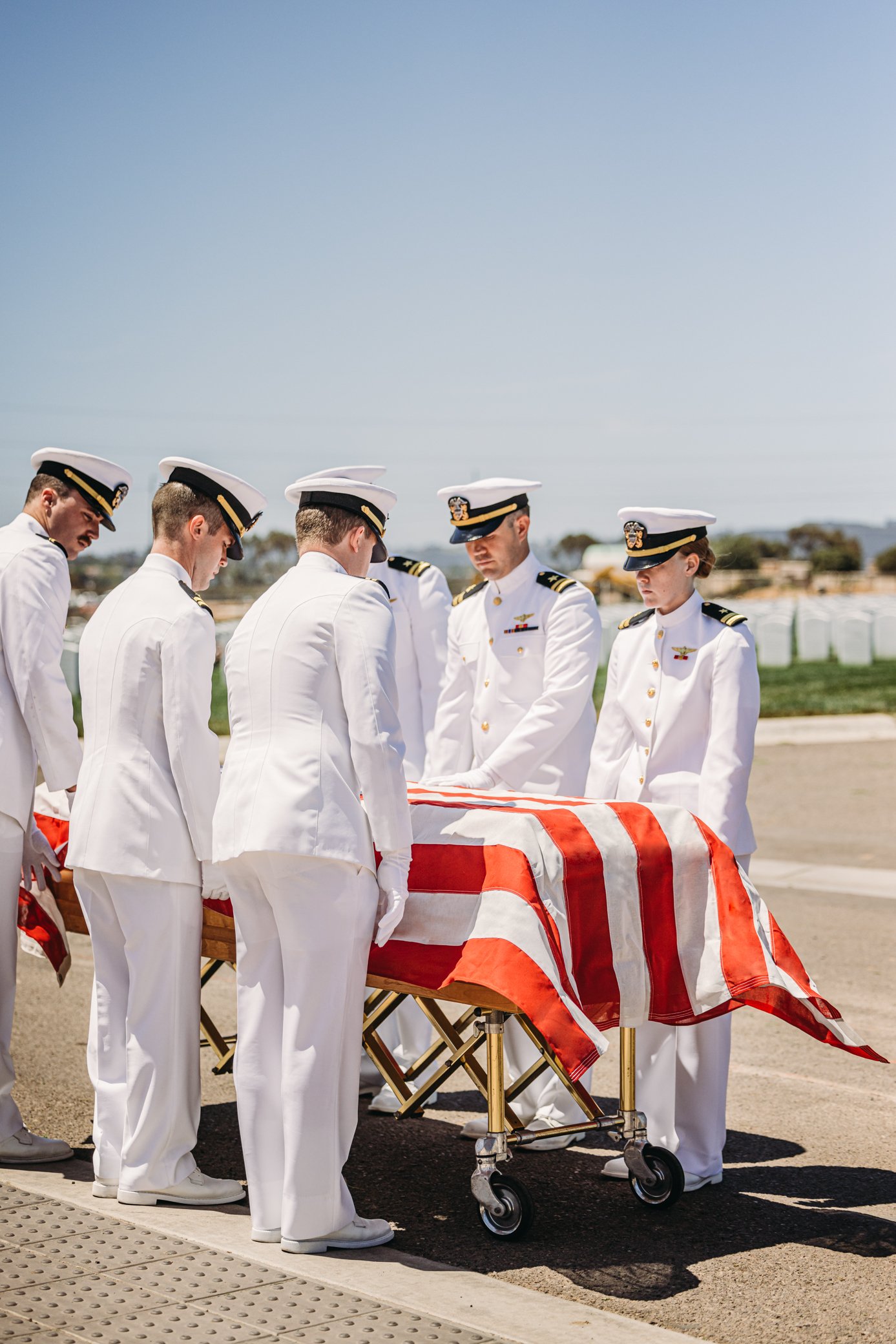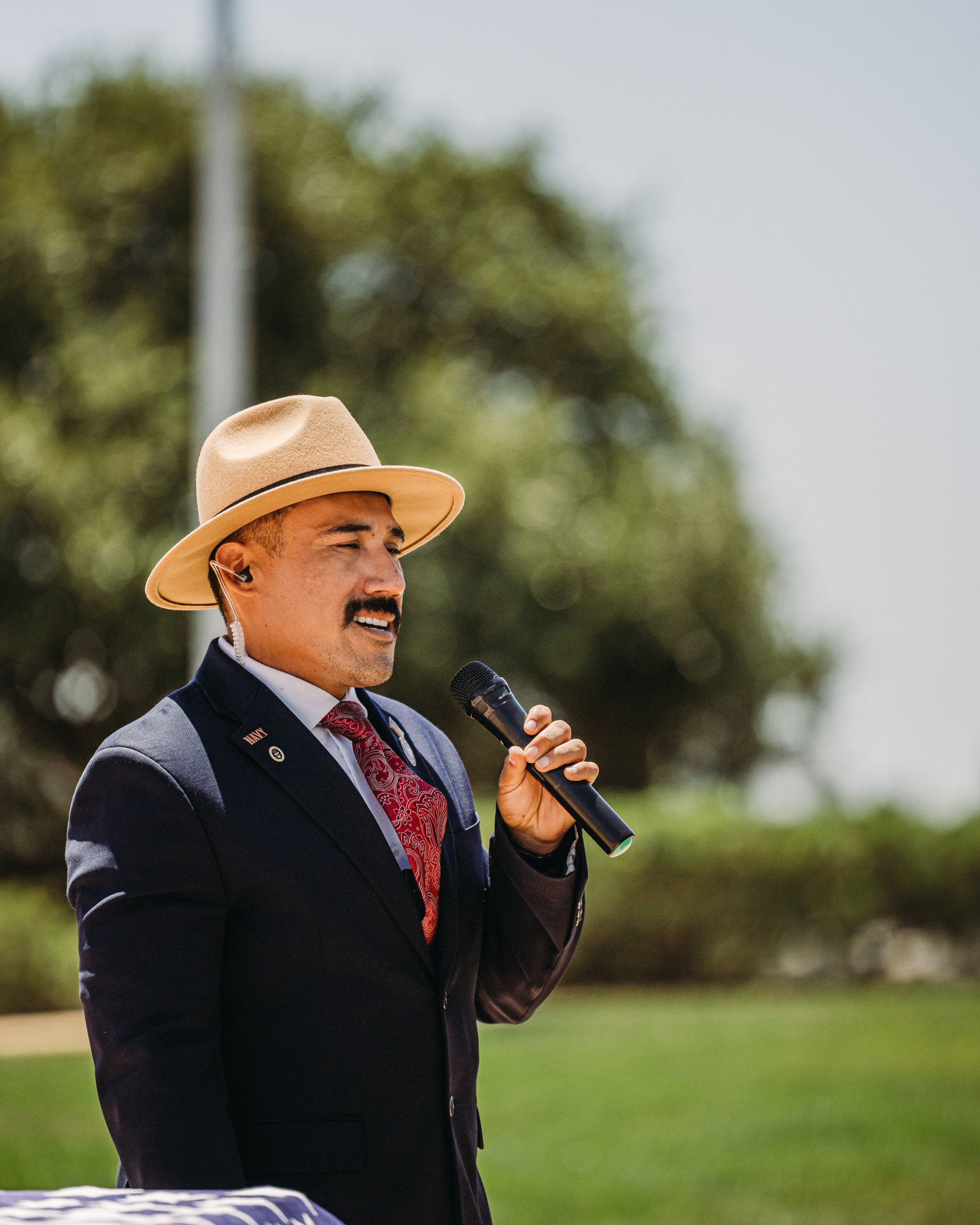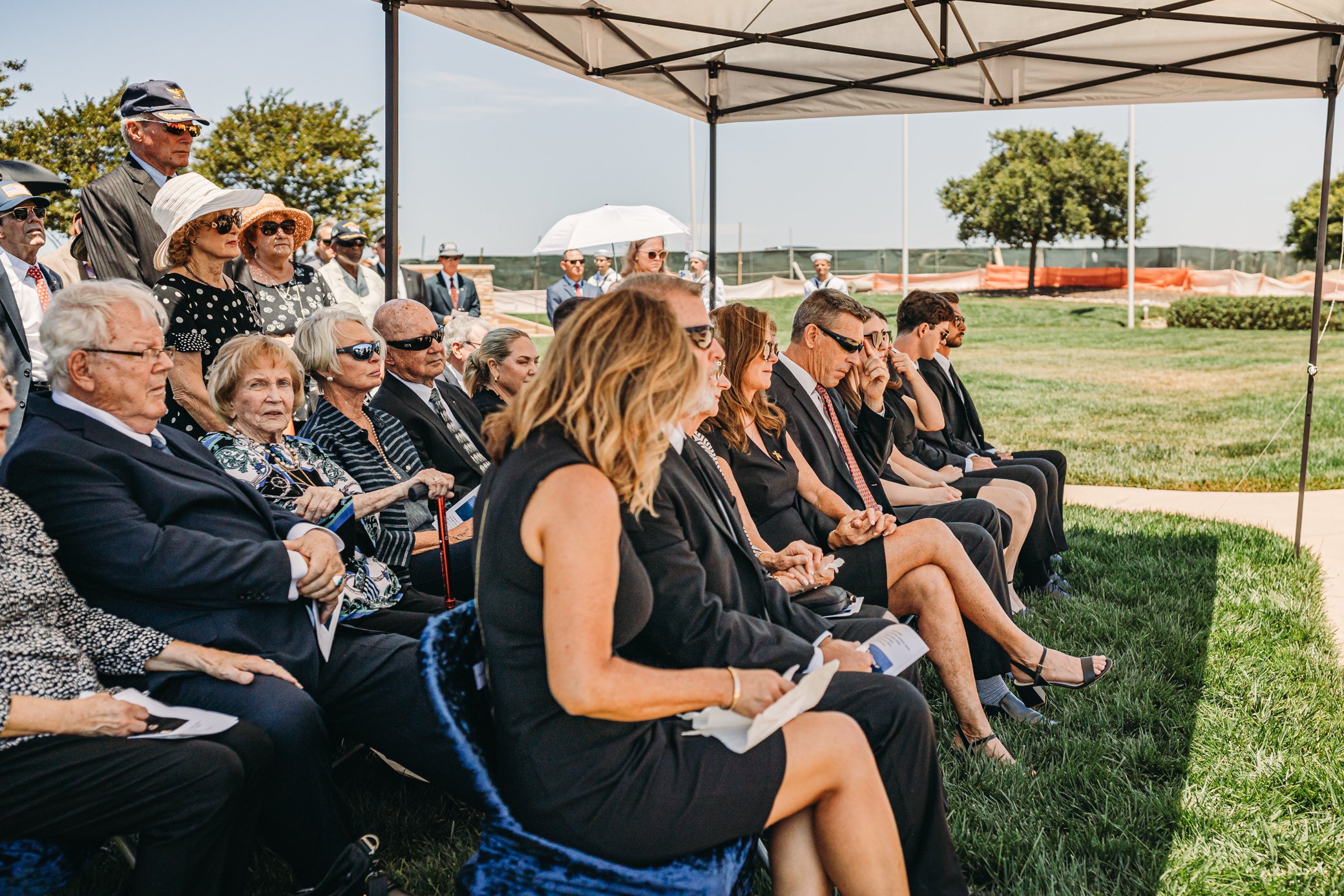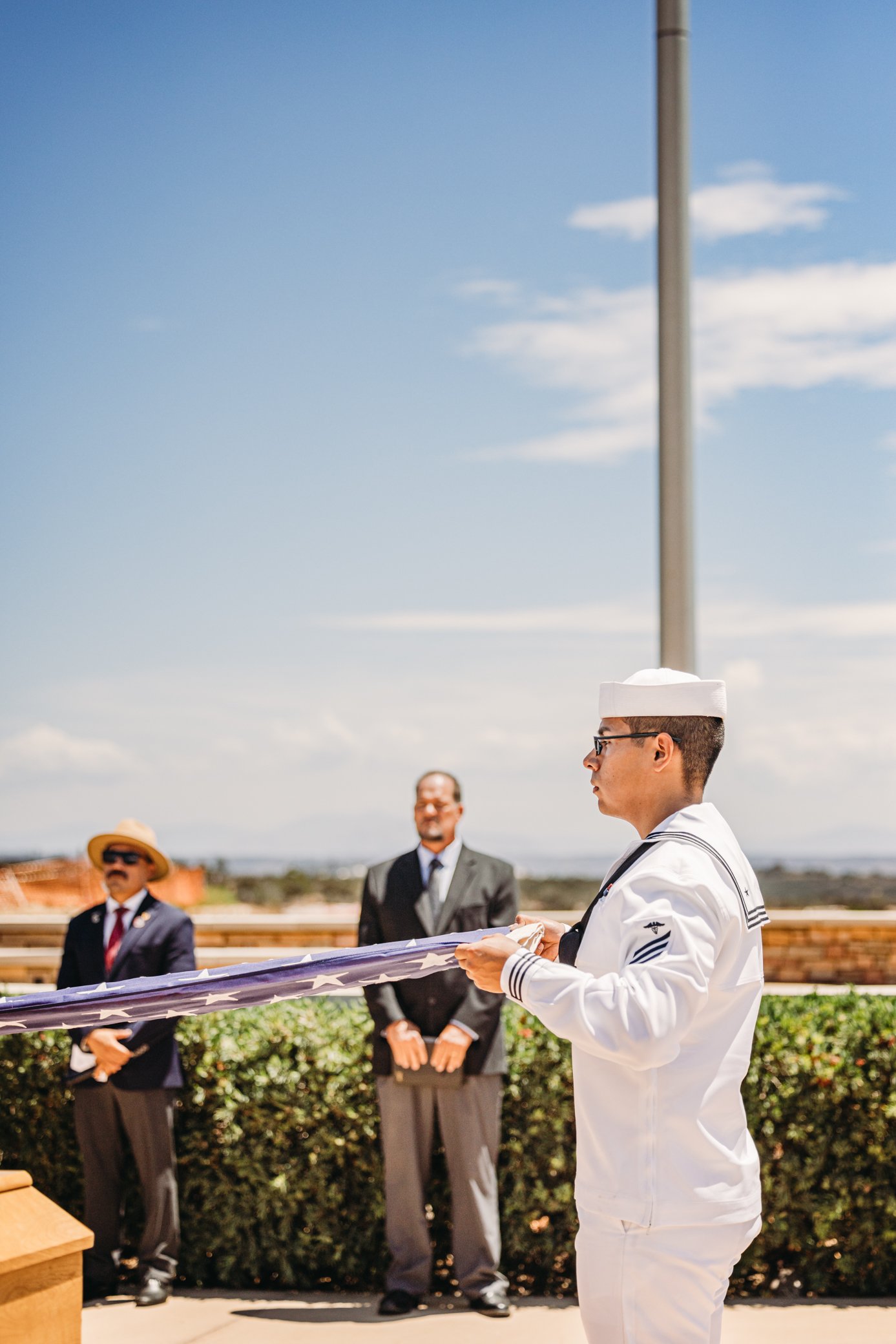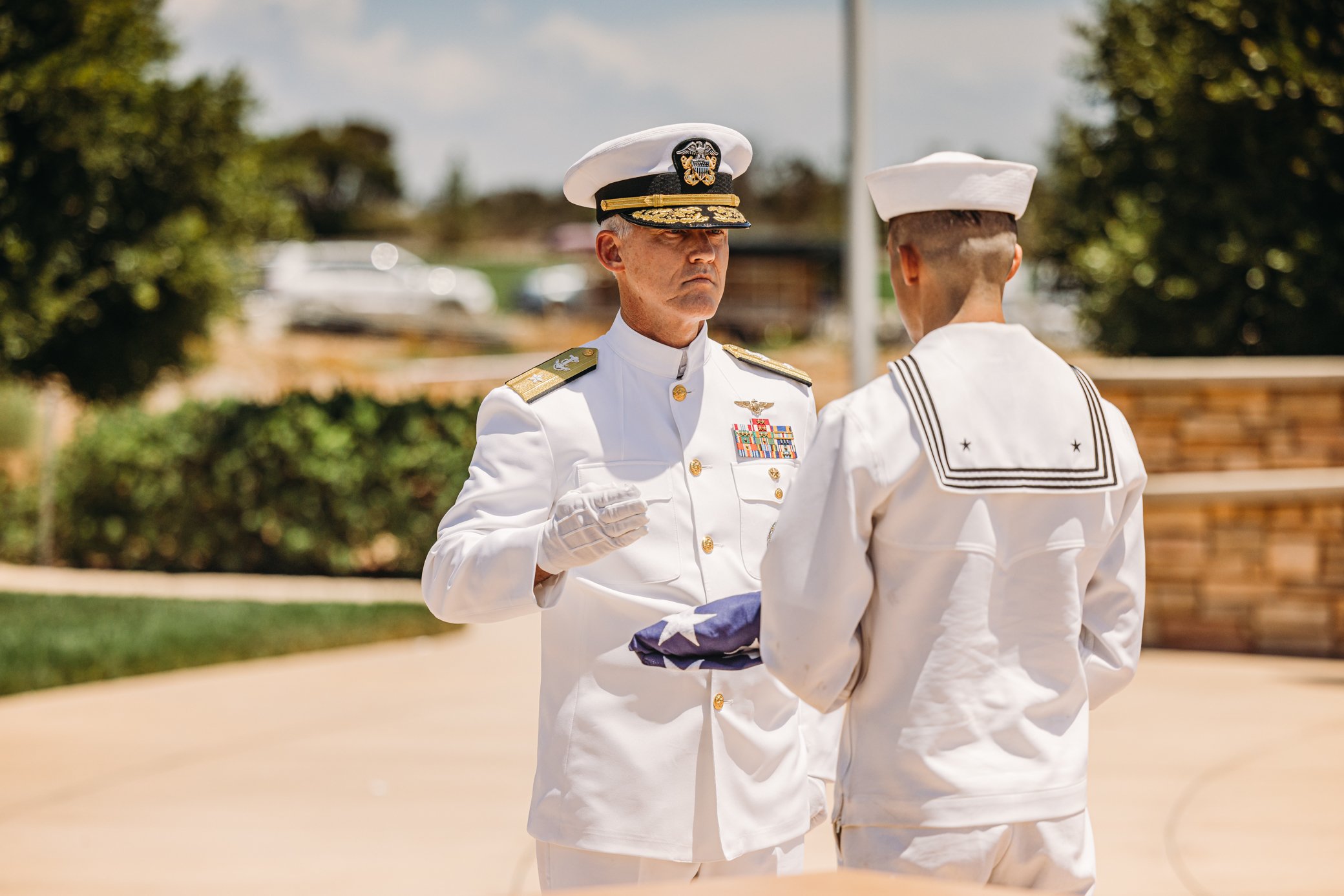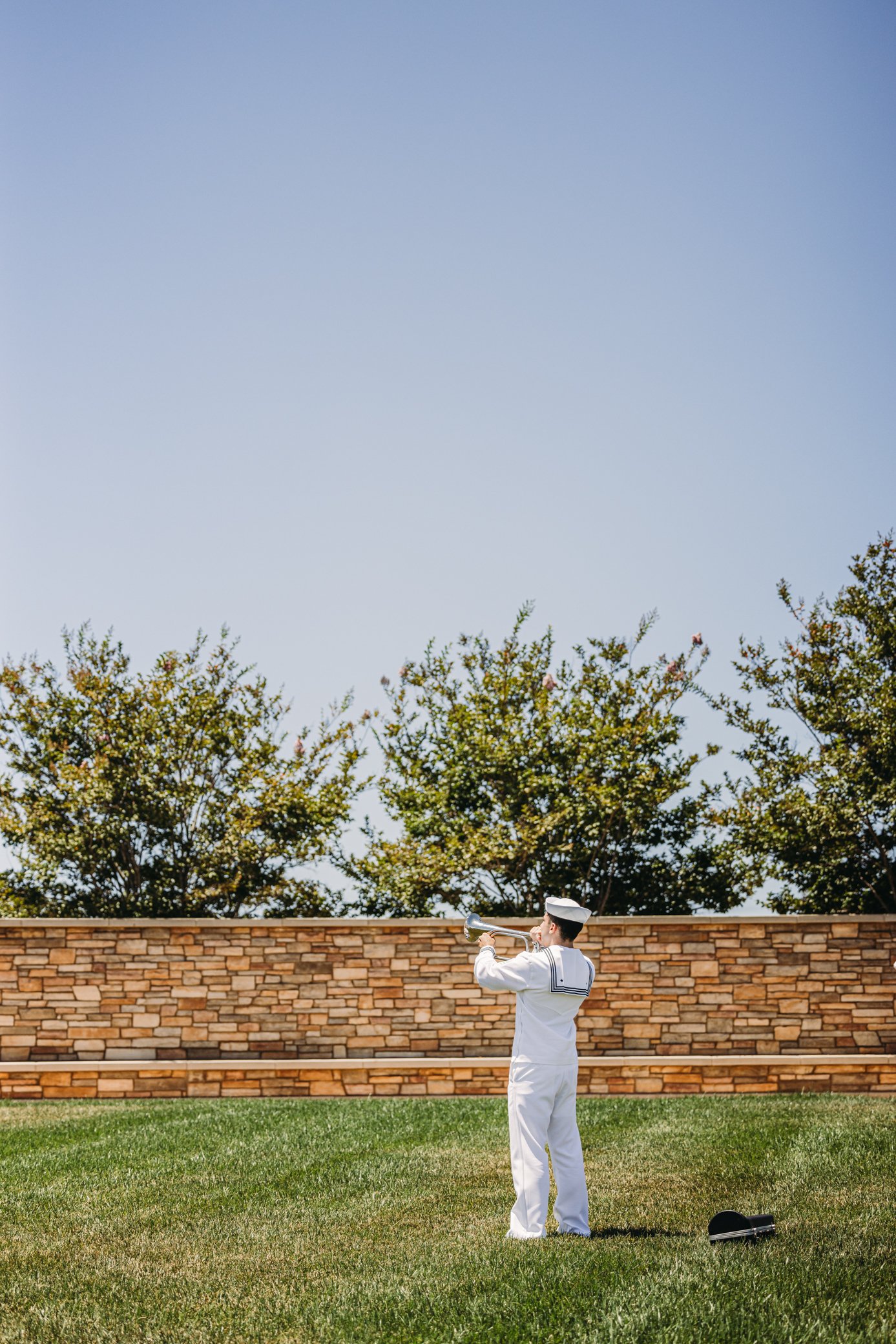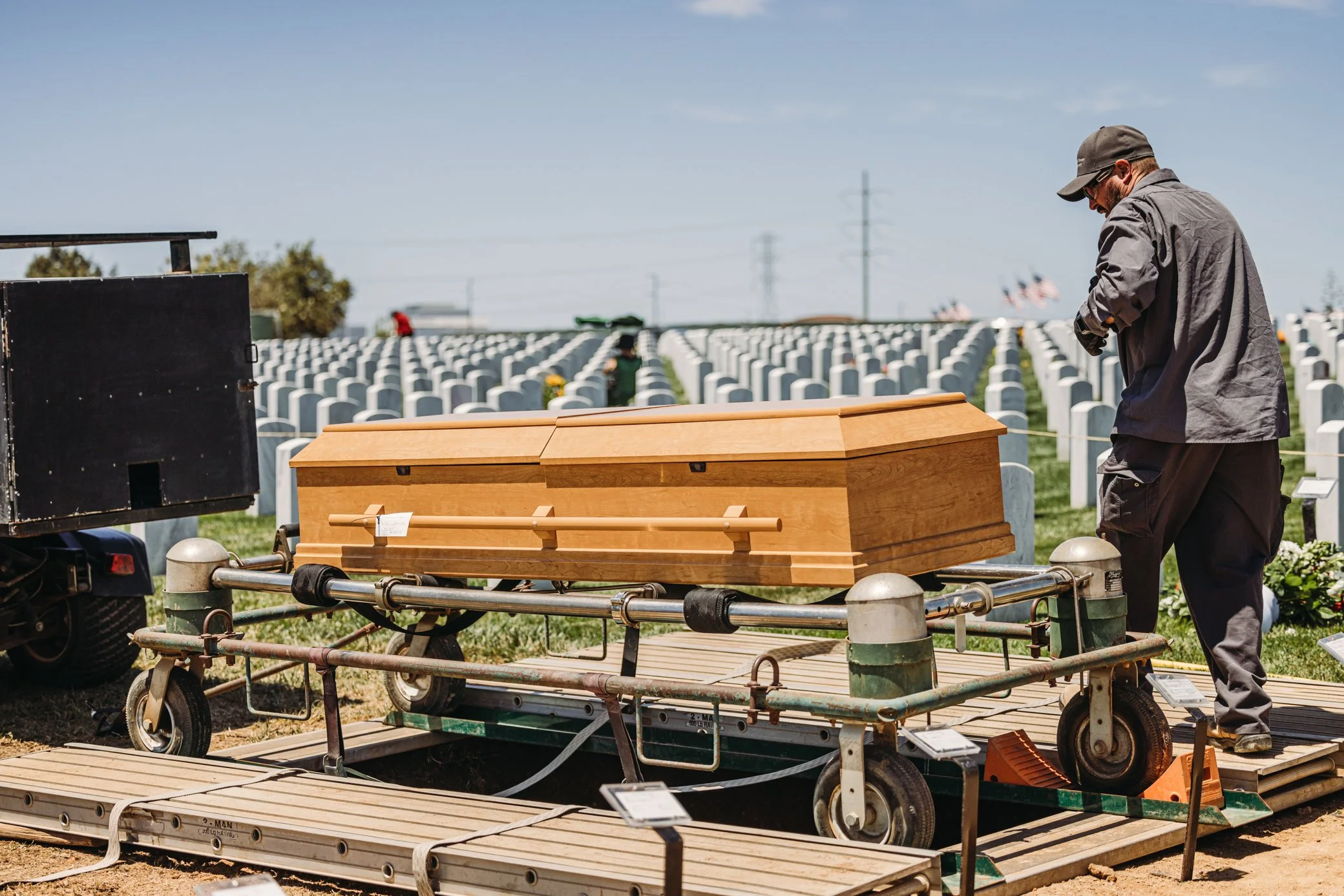Honoring Rear Admiral William E. Terry, | 33 Year Navy Veteran
Rear Admiral William E. Terry’s Military Honors were rendered at Miramar National Cemetery after his passing in 2022.
William Edwin Terry
9 January 1940 – 10 Jul 2022
VIETNAM | US NAVY, Rear Admiral Lower Half
Rear Admiral Willian Edwin Terry, USN (Ret.) was born 9 January 1940 in Borger, Texas. Bill lived in Texas until age 13 then moved with his family to Colorado where he played football in high school, was an avid hunter, camper and outdoorsman. He was accepted to college on a football scholarship, attending Adams State College and Colorado State University before being accepted to the Naval Aviation Cadet (NAVCAD) Program in 1961. Bill’s journey to his Wings of Gold began with enlistment in the U.S. Naval Reserve, pre-flight training at NAS Pensacola, followed by primary flying with VT-1 at NAS Saufley Field. He received his Wings of Gold and commission as an Ensign on 12 April 1963.
Bill received numerous personal decorations, including the Navy Distinguished Service Medal, Silver Star, Defense Superior Service Medal, two Legion of Merits, three Meritorious Service Medals, and the Air Medal. He rose through Navy ranks from a NAVCAD to become a Flag Officer, flew 5,753 flight hours, more than 5,000 in the H-3 alone, made 1,865 rotary wing shipboard landings, flew 32 combat missions on three Vietnam deployments, commanded two HS squadrons (winning the Thach and Isbell Awards), an LPH, an Amphibious Squadron, and a Logistics Group, made six non-combat rescues and received the Silver Star as a LTJG for a rescue in combat. His first Flag Officer assignment was to the staff of the Commander Allied Forces Southern Europe (AFSOUTH) for duty as the Assistant Chief of Staff for Logistics for more than two years, followed by command once more, this time as the Commander, Combat Logistics Group 2. He retired from the Navy in October 1994 after more than 33 years of service. He knew the H-3 like no other helo pilot and flew it like it was part of his body. Bill was honored and extremely proud to be a Golden Eagle. He will truly be missed.
After retirement, Bill worked for DBM and Wells Fargo Securities, wrote over a dozen books both non-fiction and fiction, including his autobiography. Most of his books star his grandchildren as the main characters. Bill’s daughter Shannon said, “He loved his life and family. He would say, don’t be sad, I had a great life. I’m so proud of my family, my Navy and my country.” RDML Terry is survived by his loving wife, Johanna, his sisters Ann Cochran and Kay Galeener, his brother Ralph Lee Terry, daughter Shannon Nembach, her husband Henry, their daughters Casey and Cameron, and his son, Michael, his wife Sandy, and their sons, Sam and Jake.
( photos continued)
Sam Cox (Rear Adm. USN, Ret.), Director, Naval History and Heritage Command wrote this on July 29, 2022
It is with deep regret I inform you of the passing of Rear Admiral (lower half) William Edwin “Bill” Terry, U.S. Navy (Retired), on 10 July 2022 at age 82. Bill entered the U.S. Naval Reserve in June 1961, was commissioned in April 1963, and served as a naval aviator flying helicopters until his retirement in October 1994 as Commander, Combat Logistics Group TWO. His other commands included Helicopter Antisubmarine Squadron EIGHT (HS-2), Helicopter Antisubmarine Squadron TEN (HS-10), USS Okinawa (LPH-3), and Amphibious Squadron SEVEN. He flew 32 combat missions during three Vietnam War deployments and he was awarded a Silver Star for rescuing three survivors from two downed aircraft under heavy enemy fire in March 1966.
Bill Terry attended Adams State College and Colorado State University on a football scholarship before enlisting in the Naval Reserve on 28 June 1961, entering the Naval Aviation Cadet program that 31 August. Following initial instruction at Naval Air Station (NAS) Pensacola, he commenced flight training at Saufley Field, Pensacola, with Training Squadron ONE (VT-1), flying the T-34 Mentor. In April 1962, he reported to Whiting Field, Florida, flying the T-28 Trojan with VT-2 and VT-3. He conducted carrier qualifications in the T-28 with VT-5, and also flew the TC-45J Expeditor as part of Basic Training Group TEN (BTG-10). In early 1963, he reported to Ellison Field, Florida, for training in Helicopter Training Squadron EIGHT (HT-8). He was honorably discharged on 15 April 1963 and, the next day, was commissioned an ensign in the U.S. Naval Reserve, to rank from 16 September 1962, and was designated a naval aviator.
In April 1963, Ensign Terry reported to the Naval Justice School, Newport, Rhode Island, for legal officer training. In July 1963, he then reported to the SH-3 Sea King replacement squadron, HS-10, at NAS Imperial Beach, California. In January 1964, he reported to HS-4 at NAS Imperial Beach. He was promoted to lieutenant (junior grade) in March 1964. He deployed with HS-4 as part of ASW Carrier Air Group FIVE FIVE (CVSG-55) embarked on USS Yorktown (CVS-10), departing Long Beach in October 1964 and conducting air strikes into North Vietnam in February, March, and April of 1965 before returning to Long Beach in May 1965. After a short turnaround, Yorktown deployed again in January 1966 to the Gulf of Tonkin.
Lieutenant (j.g.) Terry would be awarded a Silver Star for action on 14 March 1966, when another aircraft was shot down and the two aircrewmen ejected in coastal waters under enemy fire. Terry’s Silver Star citation stated,
He unhesitatingly flew toward the area to undertake the rescue of the downed airmen. As he approached the area, another aircraft attempting to affect the rescue was also shot down by deadly fires from the enemy coastline, an offshore island, and enemy boats. Despite recommendations from other pilots on the scene that he not attempt the rescue, he flew his aircraft through the heavy and accurate enemy mortar and automatic weapons fires to rescue all three survivors of the two downed aircraft.
He was promoted to lieutenant in April 1966, augmented from the Naval Reserve in June 1966, and returned to Long Beach with Yorktown in July 1966.
In October 1966, Lieutenant Terry reported to HS-10 at NAS Imperial Beach as an instructor pilot in the H-3. In July 1969, he returned to an operational squadron, Helicopter Combat Support Squadron ONE (HC-1), deploying as officer-in-charge of HC-1 (Search and Rescue—SAR) Detachment 4, embarked on USS Hancock (CVA-19) for a Tonkin Gulf deployment. He was promoted to lieutenant commander in October 1970. Despite the halt to Operation Rolling Thunder, aircraft from Hancock struck surface-to-air missile and air defense targets in North Vietnam on 21–22 November 1969 (Operation Freedom Bait) in reaction to North Vietnamese firing on unarmed U.S. reconnaissance aircraft. HC-1 Det 4 provided SAR support to the operation. In May 1971, Lieutenant Commander Terry reported for duty under instruction to the Naval Postgraduate School, Monterey, California, earning a bachelor of arts degree in government (international relations) in 1974 and a master of science degree in management in 1974.
In December 1974, Lieutenant Commander Terry reported to HS-10 at NAS Imperial Beach for refresher training in the H-3 before being assigned in June 1975 to HS-6, also at Imperial Beach, as maintenance officer. In February 1976, he assumed duty as executive officer for the SH-3 training squadron, HS-10. In January 1977, he assumed duty as executive officer for an operational squadron, HS-8. He was promoted to commander in January 1978, and in May
1978, assumed command of HS-8. During his tenure, HS-8 was awarded the Isbell Trophy (best ASW squadron in the fleet) and the Admiral Jimmy Thach Award. In July 1979, Commander Terry was assigned to the amphibious assault ship USS Okinawa as air officer, then operations officer, and then executive officer, finding time to fly the UH-1N during a western Pacific and Indian Ocean deployment that included a port visit in Mombasa, Kenya. In October 1981, Commander Terry assumed command of HS-10 at NAS Imperial Beach.
In February 1983, Terry reported to the Office of the Chief of Naval Operations as branch head, Career Programs Branch (OP-136). He was promoted to captain in October 1983. In January 1985, following a short period under instruction at Surface Warfare Officers Schools Command in Newport, in January 1985 he assumed command of Okinawa for a deployment to the western Pacific, including a port visit to Perth, Australia. In August 1986, he reported to Commander, Cruiser-Destroyer Group ONE (COMCRUDESGRU 1) as chief of staff, the first helicopter pilot to fill that position. He made two battleship battle group deployments to the western Pacific, the first on USS New Jersey (BB-62) and the second on USS Iowa (BB-61).
In October 1987, Captain Terry assumed command of Amphibious Squadron SEVEN (PHIBRON 7), which was established in 1986 as a readiness squadron homeported in San Diego. In August 1989, he returned to the Pentagon in the Office of the CNO as deputy director, General Planning and Programming Division (OP-80B). He was selected for flag rank in December 1989. In May 1990, he reported for joint equivalent duty to Commander-in-Chief, Allied Forces Southern Europe (CINCSOUTH) as assistant chief of staff for logistics. He was promoted to rear admiral (lower half) on 1 February 1991.
In July 1992, Rear Admiral Terry assumed command of Combat Logistics Group TWO, based in Norfolk, responsible for 11,000 personnel and 26 ships providing logistics support to the fleet. He retired from active duty on 1 October 1994.
During his career, Rear Admiral Terry logged 5,753 flight hours, 5,000 of them in the H-3 (making him the all-time SH-3 flight hour leader). He made 1,865 rotary ship landings. In addition to the combat rescue in Vietnam, he made six non-combat rescues during his career.
Rear Admiral Terry’s awards include the Distinguished Service Medal; the Silver Star; Defense Superior Service Medal; Legion of Merit (two awards); Meritorious Service Medal (three awards); Air Medal; Navy Commendation Medal; Navy Unit Commendation; Meritorious Unit Commendation; Battle Efficiency Ribbon; Navy Expeditionary Medal (Korea); National Defense Service Medal (two awards); Armed Forces Expeditionary Medal; Vietnam Service Medal (five campaign stars); Sea Service Ribbon (four awards); Overseas Service Ribbon (two awards); Republic of Vietnam Armed Forces Honor Medal First Class; Republic of Vietnam Cross of Gallantry; Republic of Vietnam Gallantry Cross Unit Citation; Republic of Vietnam Campaign Medal; Expert Rifleman Ribbon; and the Expert Pistol Medal.
Following retirement from active duty, Rear Admiral Terry worked for DBM and Wells Fargo Securities. He wrote over a dozen fiction and nonfiction books, including an autobiography. He was a Naval Aviation Golden Eagle. He was also a former Naval Helicopter Association (NHA) president, NHA lifetime member #17, the 2005 Life of Service to NHA Award winner, and the 2020 NHAHS/NHA Captain Mark Starr Pioneer Award recipient.
Memorial Services will be held 8 August 2022 at 1200 at Miramar National Cemetery, San Diego.
In Rear Admiral Terry’s stellar career is a lesson for junior officers—that your moment of truth may come very early. Lieutenant (j.g.) Terry met this moment by flying “unhesitatingly” into the teeth of intense enemy anti-aircraft fire, with no regard except to rescue three comrades from two downed aircraft (one shot down before his eyes). His display of courage was rewarded by a Silver Star, but more importantly by three lives saved and the gratitude of their families. He would go on to save six more lives in non-combat rescues during his career, a lifetime accomplishment that is hard to top and something few outside the helicopter (and medical) communities ever get to experience. He also demonstrated that it is possible to stay in San Diego for almost an entire career and still get promoted—although that has to be tempered by the fact that, although homeported in San Diego, he spent many long years and months deployed at sea away from family, including three Vietnam deployments and 38 combat missions, which in an SH-3 was particularly dangerous. He achieved multiple firsts in his career,
including being the first helo pilot to serve as a chief of staff for a cruiser-destroyer group. The recognition of his squadron command (HS-8) as the best ASW squadron in the fleet was an amazing accomplishment and a testament to his leadership. He was described by those who knew him as an incredible helicopter pilot, essentially one with the machine, and 5,000 hours in the SH-3, the all-time record, is testament to that. But he was also a superb leader, mentor, and an unassuming officer who was incredibly proud of his family, his Navy, and his country. We should all be incredibly proud of his dedicated service and grateful to his family for enabling it.
Rest in Peace, Admiral Terry.
Schedule of Events
8 August 2022 Miramar National Cemetery
12:00 - Carriage Leads Procession to Amphitheater
12:05 - Carriage Arrives at Amphitheater - Family and Guests Park and Gather for Service
12:10 - Family and Guests Please Rise Military in Uniform Render Hand Salute Pallbearers Move Casket Center Stage
12:11 - Cemetery Manager - Welcome Remarks
12:12 - 12:22 - Pastor John Rose - Remarks
12:23 - Military Honors - Honor Guard - Post at Casket - Rifle Volley
12:25 - Flag Ceremony RDML Wayne Baze, USN Expeditionary Strike Group Three Presents the Flag to Mrs. Johanna Terry - Guests Please Rise - Military Members Hand Salute
12:29 - 12:30 - Taps
12:30 - Fly Over Provided by HSC-23 Wildcards
12:35 - Depart
1:00 - 4:00 - Reception MCAS Miramar Officers’ Club
Learn more about RDML William E. Terry at these websites:
usnhistory.navylive.dodlive.mil
Miramar National Cemetery San Diego, California
USA PLOT SECTION 16 SITE 1031
Continue to Honor Their Life
While saying goodbye to a loved one can be a difficult and emotional experience, it helps to honor their life and remember how they impacted their family, friends, and country. When a Veteran passes on, we know that their legacy lives on in the lives of those who saw their selfless acts and learned that there are some things that are more important than your own life.
We want to walk with you through the process of planning for death. If you are a Veteran, we can help you put a plan into place for your funeral and your family’s future. If you are a survivor and need help planning for a Veteran’s arrangements, our professionals on staff would appreciate the chance to serve you as you walk this grief journey.
VETERANS LEGACY MEMORIAL (VLM)
VLM is a digital platform dedicated to the memory of the nearly 4.5 million Veterans. VLM interactive features allow you to post Tributes (comments), upload images, share your Veteran's military service timeline and achievements, biographical information, historical documents and more. You can search and post for a Veteran HERE.
If you want photos of your Veterans Funeral or Celebration of life photo’s like this, let me know right HERE!
Follow us on Instagram and Facebook








Recent Military Stories
If you want photos of your Veterans Funeral or Celebration of life photo’s like this, let me know right HERE!
Instagram Journey
All Recent Blogs
San Diego Military Stories
Tag Cloud
- Military San Diego
- Families
- San Diego Military Photographer
- Portraits
- Couples
- San Diego Events
- US Marine Corps
- Military Homecoming San Diego
- Newborn
- Post-Deployment
- San Diego Marines
- Navy Photographer
- Military Funeral
- Veteran
- Studio Portraiture Work
- San Diego Newborn
- United States Navy
- Children Portraits
- Miramar National Cemetery
- Navy Officer
- Naval Base San Diego
- Photographer Life
- Marine Corps Recruit Depot
- Funeral
- Newborn Photo Tips
- New Marine Parent
- Morning Owl Fine Art Photography
- Marine Drill Instructor
- Extended Family Session
- San Diego Military
- Female Service Member
- Lifestyle
- Military
- Family Updates
- Award Ceremony
- San Diego Military Events
- Airport Homecoming
- Newborn Lifestyle
- Personal Update
- Marine Bootcamp Graduation Tips
- Client Closet
- Engagement
- US Navy
- Dogs
- San Diego International Airport
- Styled Session
- Wedding
- Deployed Mom
- Elopement
- Military Advice
- Navy Photos
- Courthouse Elopement
- San Diego Courthouse Wedding
- Military Traditions
- Newborn Boy
- Marine Boot Camp San Diego
- Fresh 48
- Author Recommendations
- San Diego Maternity
- Military Officer
- Military Graduation
- Military Portraits
- Newborn Fresh 48
- Military History
- BalticBorn
- Big Sister
- Dog Friendly Photographer
- San Diego Beach Photo Session
- Big Brother
- Self Portraits
- New Dad
- United States Sailor
- USNS Mercy
- Pet Friendly Maternity Photographer
- HM
- Nursing Portraits
- Maternity Photos with Dogs
- E6 in 6 Years
- Marine Corps Martial Arts Instructor
- COVID-19
- Cambodian American Service Members
- One Year Milestone Session
- United States Marine Corps
- Graduation Photos
- Pregnancy Loss
- Navy Portraits
- Bali Hai Restaurant San Diego
- Female Marines
- Custom Retirement Ceremony
- Grief & Loss
- San Diego Event Photographer
- Submarine
- First Baby
- Sand Dunes
- Miscarriage Support
- Marine Homecoming
- Military Spouse
- Military Success Stories
- Pregnancy Photos
- Remembrance Photos


